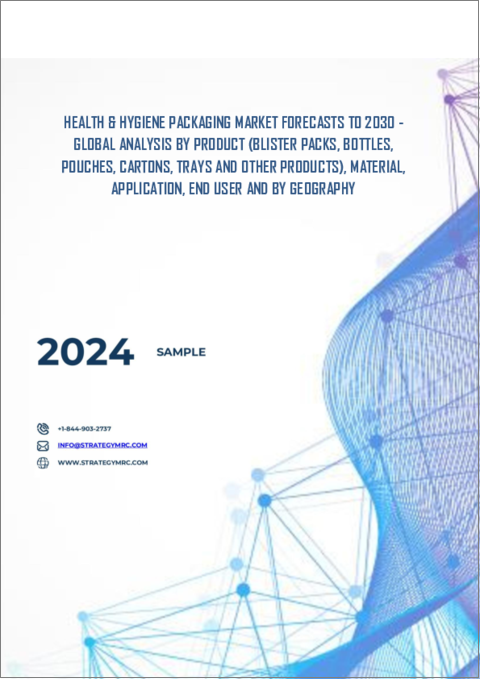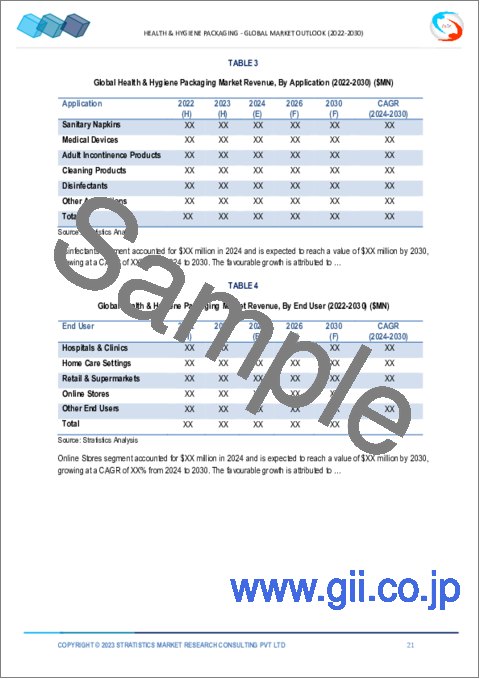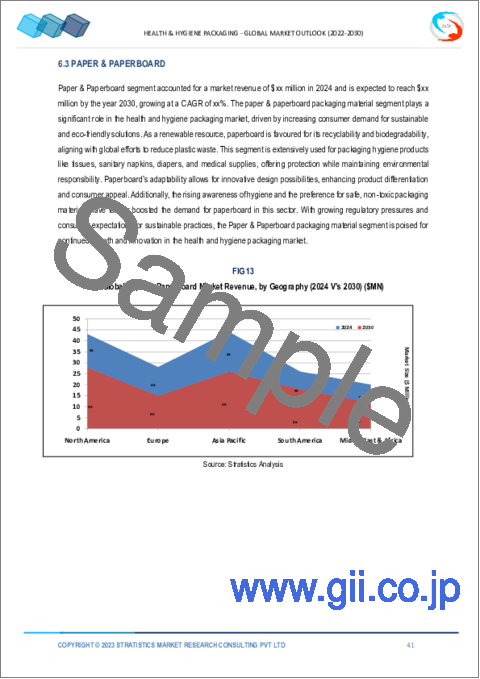|
|
市場調査レポート
商品コード
1530679
ヘルスおよび衛生向けパッケージング市場の2030年までの予測:製品別、材料別、用途別、エンドユーザー別、地域別の世界分析Health & Hygiene Packaging Market Forecasts to 2030 - Global Analysis By Product (Blister Packs, Bottles, Pouches, Cartons, Trays and Other Products), Material, Application, End User and By Geography |
||||||
カスタマイズ可能
|
|||||||
| ヘルスおよび衛生向けパッケージング市場の2030年までの予測:製品別、材料別、用途別、エンドユーザー別、地域別の世界分析 |
|
出版日: 2024年08月01日
発行: Stratistics Market Research Consulting
ページ情報: 英文 200+ Pages
納期: 2~3営業日
|
全表示
- 概要
- 図表
- 目次
Stratistics MRCによると、世界のヘルスおよび衛生向けパッケージング市場は2024年に1,122億1,000万米ドルを占め、2030年には1,506億2,000万米ドルに達すると予測され、予測期間中にCAGR 7.9%で成長する見込みです。
ヘルスおよび衛生向けパッケージングとは、ヘルスケアや個人衛生で使用される製品の無菌性、清潔性、安全性を維持するために設計された特殊な包装を指します。このタイプの包装は、汚染からの保護、製品の完全性の保持を保証し、多くの場合、タンパーエビデンス、開封しやすいデザイン、微生物の繁殖を防ぐ素材などの特徴を含んでいます。保健衛生包装は、厳しい規制基準を遵守し、ユーザーの安全性を高めることで、公衆衛生を守る上で重要な役割を果たしています。
食品医薬品局(FDA)によると、DQSAのタイトルIIである医薬品サプライチェーン・セキュリティ法(DSCSA)は、米国内で流通する特定の処方薬を識別・追跡するために、パッケージレベルで製品の相互運用可能な電子追跡を達成するための手順を概説しています。
慢性疾患の増加
糖尿病や心血管疾患などの慢性疾患の増加は、医薬品、医療機器、在宅ヘルスケア製品の需要を増大させています。患者は頻繁な投薬、監視装置、衛生用品を必要とするため、無菌性、安全性、ユーザーの利便性を確保する包装ニーズが高まっています。このような需要の高まりにより、製品の完全性を維持しながら規制基準に準拠する先進パッケージングソリューションが必要となり、最終的にヘルスおよび衛生向けパッケージングング技術の市場拡大と技術革新に寄与しています。
厳しい規制基準
保健衛生包装における厳しい規制基準は、製品の安全性、無菌性、消費者保護を保証するものです。これらの基準は公衆衛生にとって極めて重要である一方、市場成長にとって課題となることもあります。コンプライアンスには、試験、認証、進化する規制への継続的な適応に多大な投資が必要であり、メーカーにとってはコストと市場投入までの時間を増大させる可能性があります。さらに、地域によって異なる規制の枠組みをうまく利用することは、複雑でリソースを必要とするため、市場の拡大とイノベーションを制限する可能性があります。
パンデミック後の衛生意識の高まり
汚染防止への関心の高まりにより、開封防止、滅菌、廃棄が容易な包装ソリューションへの需要が急増しています。医薬品やパーソナルケアなどの業界は、こうした期待の高まりに応えるため、革新的なパッケージングに投資しています。さらに、eコマースの台頭は、安全な製品配送を確実にするために、耐久性があり衛生的なパッケージングの必要性を高めています。その結果、パンデミック後の衛生意識の高まりは、消費者が安全性と清潔さを優先するようになり、ヘルスおよび衛生向けパッケージング市場の成長を大きく後押ししています。
環境への配慮
ヘルスおよび衛生向けパッケージングにおける環境への懸念は、主に非生分解性プラスチックの使用と過剰な包装廃棄物に関連しており、これらは汚染と埋立地のオーバーフローの原因となっています。持続可能性に対する消費者の意識の高まりは、企業に環境に優しい素材や慣行の採用を迫っています。こうした要求は、生産コストの上昇や持続可能な代替品の調達という課題につながる可能性があります。さらに、包装材料に関する規制の監視はコンプライアンスを複雑にし、市場の成長を妨げる可能性があります。
COVID-19の影響
COVID-19の大流行は、衛生意識の高まりと医療用品、個人用保護具、除菌製品の需要増加により、保健衛生包装市場を大幅に押し上げました。この急増は、製品の安全性と無菌性を確保する包装ソリューションの急速な拡大につながった。さらに、健康関連製品のeコマースの成長により、安全な配送を確保するための堅牢で衛生的な包装のニーズが高まっています。
予測期間中、紙・板紙製品分野が最大となる見込み
紙・板紙製品セグメントは有利な成長が見込まれます。紙と板紙材料を使用したヘルス&ヘルスケア包装は、ヘルスケアと衛生分野の製品を保護するための持続可能な選択肢を提供します。これらの素材は軽量でリサイクル可能であり、耐湿性や滅菌処理も可能です。また、改ざん防止シールやイージーオープン設計が施されていることが多く、製品の安全性と使用者の利便性を保証します。紙ベースの包装は、医療用品、パーソナルケア用品、衛生用品など様々な用途に適しており、環境に優しい包装ソリューションに貢献しています。
クリーニング製品分野は予測期間中に最も高いCAGRが見込まれる
クリーニング製品分野は予測期間中に最も高いCAGR成長が見込まれます。健康と衛生洗浄剤用の包装は、製剤が汚染されず効果的であることを保証します。この包装には、改ざん防止シール、小児用耐性クロージャー、化学薬品に耐性のある素材が使用されることが多いです。安全な使用のために明確なラベルを提供しながら、有効成分の完全性を維持するのに役立ちます。さらに、このような包装は安全な廃棄とリサイクルを促進し、環境持続可能性の目標に沿うとともに、取り扱いや使用時の利便性と安全性を高める。
最大のシェアを占める地域
アジア太平洋地域は、健康意識の高まりと高齢者人口の増加に牽引され、予測期間中最大の市場シェアを占めると予測されます。中国やインドのような国では、医薬品、医療機器、パーソナルケア製品の需要が高まっており、革新的なパッケージングソリューションが必要とされています。厳しい規制基準が、製品の安全性と無菌性を保証するコンプライアンス包装の必要性をさらに高めています。さらに、eコマースの急増と持続可能な包装オプションに対する消費者の嗜好の変化が市場力学を形成しており、この地域を世界の保健衛生包装の展望における主要プレーヤーにしています。
CAGRが最も高い地域:
北米は、衛生と健康の安全性に対する消費者の意識の高まりにより、予測期間中に最も高いCAGRを有すると予測されています。革新的なパッケージングソリューション、特にクリーニング製品、パーソナルケアアイテム、医療用品の需要が増加しています。主な動向には、環境に優しい素材や、ユーザーの利便性を高めるスマートパッケージング技術などがあります。安全基準に関する規制圧力が市場拡大をさらに後押ししています。大手企業は持続可能な取り組みに注力し、環境意識の高い消費者に対応しており、eコマースの成長はこの分野の流通チャネルを再構築しています。
無料カスタマイズサービス:
本レポートをご購読のお客様には、以下の無料カスタマイズオプションのいずれかをご利用いただけます:
- 企業プロファイル
- 追加市場プレーヤーの包括的プロファイリング(3社まで)
- 主要企業のSWOT分析(3社まで)
- 地域セグメンテーション
- 顧客の関心に応じた主要国の市場推計・予測・CAGR(注:フィージビリティチェックによる)
- 競合ベンチマーキング
- 製品ポートフォリオ、地理的プレゼンス、戦略的提携に基づく主要企業のベンチマーキング
目次
第1章 エグゼクティブサマリー
第2章 序文
- 概要
- ステークホルダー
- 調査範囲
- 調査手法
- データマイニング
- データ分析
- データ検証
- 調査アプローチ
- 調査情報源
- 1次調査情報源
- 2次調査情報源
- 前提条件
第3章 市場動向分析
- 促進要因
- 抑制要因
- 機会
- 脅威
- 製品分析
- 用途分析
- エンドユーザー分析
- 新興市場
- COVID-19の影響
第4章 ポーターのファイブフォース分析
- 供給企業の交渉力
- 買い手の交渉力
- 代替品の脅威
- 新規参入業者の脅威
- 競争企業間の敵対関係
第5章 世界のヘルスおよび衛生向けパッケージング市場:製品別
- ブリスターパック
- ボトル
- ポーチ
- カートン
- トレイ
- その他の製品
第6章 世界のヘルスおよび衛生向けパッケージング市場:材料別
- プラスチック
- ポリエチレン(PE)
- ポリプロピレン(PP)
- ポリ塩化ビニル(PVC)
- ポリエチレンテレフタレート(PET)
- 紙・板紙
- 金属
- ガラス
- その他の資料
第7章 世界のヘルスおよび衛生向けパッケージング市場:用途別
- 生理用ナプキン
- 医療機器
- 大人用失禁用品
- クリーニング製品
- 消毒剤
- その他のアプリケーション
第8章 世界のヘルスおよび衛生向けパッケージング市場:エンドユーザー別
- 病院・クリニック
- ホームケア設定
- 小売店とスーパーマーケット
- オンラインストア
- その他のエンドユーザー
第9章 世界のヘルスおよび衛生向けパッケージング市場:地域別
- 北米
- 米国
- カナダ
- メキシコ
- 欧州
- ドイツ
- 英国
- イタリア
- フランス
- スペイン
- その他欧州
- アジア太平洋
- 日本
- 中国
- インド
- オーストラリア
- ニュージーランド
- 韓国
- その他アジア太平洋地域
- 南米
- アルゼンチン
- ブラジル
- チリ
- その他南米
- 中東・アフリカ
- サウジアラビア
- アラブ首長国連邦
- カタール
- 南アフリカ
- その他中東とアフリカ
第10章 主な発展
- 契約、パートナーシップ、コラボレーション、合弁事業
- 買収と合併
- 新製品発売
- 事業拡大
- その他の主要戦略
第11章 企業プロファイリング
- Amcor PLC
- Berry Global Inc.
- Mondi Group
- Reynolds Group Holdings
- Sealed Air Corporation
- Sonoco Products Company
- WestRock Company
- Avery Dennison Corporation
- Bemis Company
- CCL Industries Inc.
- Clondalkin Group Holdings B.V.
- DS Smith PLC
- Huhtamaki Oyj
- International Paper Company
- Klockner Pentaplast Group
- ProAmpac LLC
- Smurfit Kappa Group
- Stora Enso Oyj
- Tetra Pak International S.A.
- Winpak Limited
List of Tables
- Table 1 Global Health & Hygiene Packaging Market Outlook, By Region (2022-2030) ($MN)
- Table 2 Global Health & Hygiene Packaging Market Outlook, By Product (2022-2030) ($MN)
- Table 3 Global Health & Hygiene Packaging Market Outlook, By Blister Packs (2022-2030) ($MN)
- Table 4 Global Health & Hygiene Packaging Market Outlook, By Bottles (2022-2030) ($MN)
- Table 5 Global Health & Hygiene Packaging Market Outlook, By Pouches (2022-2030) ($MN)
- Table 6 Global Health & Hygiene Packaging Market Outlook, By Cartons (2022-2030) ($MN)
- Table 7 Global Health & Hygiene Packaging Market Outlook, By Trays (2022-2030) ($MN)
- Table 8 Global Health & Hygiene Packaging Market Outlook, By Other Products (2022-2030) ($MN)
- Table 9 Global Health & Hygiene Packaging Market Outlook, By Material (2022-2030) ($MN)
- Table 10 Global Health & Hygiene Packaging Market Outlook, By Plastics (2022-2030) ($MN)
- Table 11 Global Health & Hygiene Packaging Market Outlook, By Polyethylene (PE) (2022-2030) ($MN)
- Table 12 Global Health & Hygiene Packaging Market Outlook, By Polypropylene (PP) (2022-2030) ($MN)
- Table 13 Global Health & Hygiene Packaging Market Outlook, By Polyvinyl Chloride (PVC) (2022-2030) ($MN)
- Table 14 Global Health & Hygiene Packaging Market Outlook, By Polyethylene Terephthalate (PET) (2022-2030) ($MN)
- Table 15 Global Health & Hygiene Packaging Market Outlook, By Paper & Paperboard (2022-2030) ($MN)
- Table 16 Global Health & Hygiene Packaging Market Outlook, By Metal (2022-2030) ($MN)
- Table 17 Global Health & Hygiene Packaging Market Outlook, By Glass (2022-2030) ($MN)
- Table 18 Global Health & Hygiene Packaging Market Outlook, By Other Materials (2022-2030) ($MN)
- Table 19 Global Health & Hygiene Packaging Market Outlook, By Application (2022-2030) ($MN)
- Table 20 Global Health & Hygiene Packaging Market Outlook, By Sanitary Napkins (2022-2030) ($MN)
- Table 21 Global Health & Hygiene Packaging Market Outlook, By Medical Devices (2022-2030) ($MN)
- Table 22 Global Health & Hygiene Packaging Market Outlook, By Adult Incontinence Products (2022-2030) ($MN)
- Table 23 Global Health & Hygiene Packaging Market Outlook, By Cleaning Products (2022-2030) ($MN)
- Table 24 Global Health & Hygiene Packaging Market Outlook, By Disinfectants (2022-2030) ($MN)
- Table 25 Global Health & Hygiene Packaging Market Outlook, By Other Applications (2022-2030) ($MN)
- Table 26 Global Health & Hygiene Packaging Market Outlook, By End User (2022-2030) ($MN)
- Table 27 Global Health & Hygiene Packaging Market Outlook, By Hospitals & Clinics (2022-2030) ($MN)
- Table 28 Global Health & Hygiene Packaging Market Outlook, By Home Care Settings (2022-2030) ($MN)
- Table 29 Global Health & Hygiene Packaging Market Outlook, By Retail & Supermarkets (2022-2030) ($MN)
- Table 30 Global Health & Hygiene Packaging Market Outlook, By Online Stores (2022-2030) ($MN)
- Table 31 Global Health & Hygiene Packaging Market Outlook, By Other End Users (2022-2030) ($MN)
Note: Tables for North America, Europe, APAC, South America, and Middle East & Africa Regions are also represented in the same manner as above.
According to Stratistics MRC, the Global Health & Hygiene Packaging Market is accounted for $112.21 billion in 2024 and is expected to reach $150.62 billion by 2030 growing at a CAGR of 7.9% during the forecast period. Health & Hygiene Packaging refers to specialized packaging designed to maintain the sterility, cleanliness, and safety of products used in healthcare and personal hygiene. This type of packaging ensures protection against contamination, preserves product integrity, and often includes features like tamper-evidence, easy-to-open designs, and materials that prevent microbial growth. Health & hygiene packaging plays a crucial role in safeguarding public health by adhering to stringent regulatory standards and enhancing user safety.
According to Food & Drug Administration, Title II of DQSA, the Drug Supply Chain Security Act (DSCSA), outlines steps to accomplish interoperable, electronic tracing of products at the package level to identify and trace certain prescription drugs as they are distributed in the United States.
Market Dynamics:
Driver:
Increased prevalence of chronic diseases
The increased prevalence of chronic diseases, such as diabetes and cardiovascular conditions, escalates the demand for pharmaceuticals, medical devices, and home healthcare products. Patients require frequent medication, monitoring devices, and hygiene products, leading to greater packaging needs that ensure sterility, safety, and user convenience. This rising demand necessitates advanced packaging solutions that comply with regulatory standards while maintaining product integrity, ultimately contributing to market expansion and innovation in health and hygiene packaging technologies.
Restraint:
Stringent regulatory standards
Stringent regulatory standards in health & hygiene packaging ensure product safety, sterility, and consumer protection. While these standards are crucial for public health, they can also pose challenges for market growth. Compliance requires significant investment in testing, certification, and continuous adaptation to evolving regulations, which can increase costs and time-to-market for manufacturers. Additionally, navigating varying regulatory frameworks across different regions can be complex and resource-intensive, potentially limiting market expansion and innovation.
Opportunity:
Heightened hygiene awareness post-pandemic
The increased focus on preventing contamination has led to a surge in demand for packaging solutions that offer tamper-evidence, sterilization, and easy disposal. Industries, including pharmaceuticals and personal care, are investing in innovative packaging to meet these heightened expectations. Additionally, the rise of e-commerce has amplified the need for durable and hygienic packaging to ensure safe product delivery. Consequently, heightened hygiene awareness post-pandemic has significantly propelled the growth of the health & hygiene packaging market as consumers prioritize safety and cleanliness.
Threat:
Environmental concerns
Environmental concerns in health & hygiene packaging primarily revolve around the use of non-biodegradable plastics and excessive packaging waste, which contribute to pollution and landfill overflow. Growing consumer awareness about sustainability pressures companies to adopt eco-friendly materials and practices. These demands can lead to increased production costs and challenges in sourcing sustainable alternatives. Additionally, regulatory scrutiny on packaging materials can complicate compliance, hindering market growth.
Covid-19 Impact
The covid-19 pandemic significantly boosted the health & hygiene packaging market due to heightened hygiene awareness and increased demand for medical supplies, personal protective equipment, and sanitization products. This surge led to a rapid expansion of packaging solutions ensuring product safety and sterility. Additionally, the growth of e-commerce for health products intensified the need for robust and hygienic packaging to ensure safe delivery.
The paper & paperboard products segment is expected to be the largest during the forecast period
The paper & paperboard products segment is estimated to have a lucrative growth. Health & Hygiene Packaging using paper and paperboard materials provides a sustainable option for safeguarding products in healthcare and hygiene sectors. These materials are lightweight, recyclable, and can be treated for moisture resistance and sterilization. They often feature tamper-evident seals and easy-open designs, ensuring product safety and user convenience. Paper-based packaging is suitable for various applications, including medical supplies, personal care items, and sanitary products, contributing to eco-friendly packaging solutions.
The cleaning products segment is expected to have the highest CAGR during the forecast period
The cleaning products segment is anticipated to witness the highest CAGR growth during the forecast period. Health & Hygiene Packaging for cleaning products ensures that formulations remain uncontaminated and effective. This packaging often features tamper-evident seals, child-resistant closures, and materials resistant to chemicals. It helps preserve the integrity of active ingredients while providing clear labeling for safe use. Additionally, such packaging promotes safe disposal and recycling options, aligning with environmental sustainability goals, while also enhancing user convenience and safety during handling and application.
Region with largest share:
Asia Pacific is projected to hold the largest market share during the forecast period driven by increasing health awareness and a rising elderly population. Countries like China and India are witnessing heightened demand for pharmaceuticals, medical devices, and personal care products, necessitating innovative packaging solutions. Stringent regulatory standards further propel the need for compliant packaging that ensures product safety and sterility. Additionally, the surge in e-commerce and changing consumer preferences towards sustainable packaging options are shaping market dynamics, making the region a key player in the global health and hygiene packaging landscape.
Region with highest CAGR:
North America is projected to have the highest CAGR over the forecast period, owing to rising consumer awareness of hygiene and health safety. The demand for innovative packaging solutions, especially for cleaning products, personal care items, and medical supplies, is on the rise. Key trends include eco-friendly materials and smart packaging technologies that enhance user convenience. Regulatory pressures regarding safety standards further fuel market expansion. Major players are focusing on sustainable practices, catering to environmentally conscious consumers, while e-commerce growth is reshaping distribution channels in this sector.
Key players in the market
Some of the key players profiled in the Health & Hygiene Packaging Market include Amcor PLC, Berry Global Inc., Mondi Group, Reynolds Group Holdings, Sealed Air Corporation, Sonoco Products Company, WestRock Company, Avery Dennison Corporation, Bemis Company, CCL Industries Inc., Clondalkin Group Holdings B.V., DS Smith PLC, Huhtamaki Oyj, International Paper Company, Klockner Pentaplast Group, ProAmpac LLC, Smurfit Kappa Group, Stora Enso Oyj, Tetra Pak International S.A. and Winpak Limited.
Key Developments:
In May 2024, Mondi, a global leader in sustainable packaging and paper, has collaborated with Scan Sverige to create a polypropylene (PP) based mono-material packaging, that is designed for recycling. Featuring a top and bottom film, Mondi's WalletPack has an easy peel mechanism ensuring consumer convenience. Created with a protective high oxygen barrier for a longer shelf-life in combination with inside print, it also offers good printability to communicate the brand and product messages.
In April 2024, Amcor, a global leader in developing and producing responsible packaging solutions, together with Kimberly Clark, has launched packaging for its Eco Protect diapers with 30% recycled materials in Peru. The bags contain post-consumer recycled content and provide a more sustainable packaging solution for the hypoallergenic diapers made with certified, plant-based fibers.
Products Covered:
- Blister Packs
- Bottles
- Pouches
- Cartons
- Trays
- Other Products
Materials Covered:
- Plastics
- Paper & Paperboard
- Metal
- Glass
- Other Materials
Applications Covered:
- Sanitary Napkins
- Medical Devices
- Adult Incontinence Products
- Cleaning Products
- Disinfectants
- Other Applications
End Users Covered:
- Hospitals & Clinics
- Home Care Settings
- Retail & Supermarkets
- Online Stores
- Other End Users
Regions Covered:
- North America
- US
- Canada
- Mexico
- Europe
- Germany
- UK
- Italy
- France
- Spain
- Rest of Europe
- Asia Pacific
- Japan
- China
- India
- Australia
- New Zealand
- South Korea
- Rest of Asia Pacific
- South America
- Argentina
- Brazil
- Chile
- Rest of South America
- Middle East & Africa
- Saudi Arabia
- UAE
- Qatar
- South Africa
- Rest of Middle East & Africa
What our report offers:
- Market share assessments for the regional and country-level segments
- Strategic recommendations for the new entrants
- Covers Market data for the years 2022, 2023, 2024, 2026, and 2030
- Market Trends (Drivers, Constraints, Opportunities, Threats, Challenges, Investment Opportunities, and recommendations)
- Strategic recommendations in key business segments based on the market estimations
- Competitive landscaping mapping the key common trends
- Company profiling with detailed strategies, financials, and recent developments
- Supply chain trends mapping the latest technological advancements
Free Customization Offerings:
All the customers of this report will be entitled to receive one of the following free customization options:
- Company Profiling
- Comprehensive profiling of additional market players (up to 3)
- SWOT Analysis of key players (up to 3)
- Regional Segmentation
- Market estimations, Forecasts and CAGR of any prominent country as per the client's interest (Note: Depends on feasibility check)
- Competitive Benchmarking
- Benchmarking of key players based on product portfolio, geographical presence, and strategic alliances
Table of Contents
1 Executive Summary
2 Preface
- 2.1 Abstract
- 2.2 Stake Holders
- 2.3 Research Scope
- 2.4 Research Methodology
- 2.4.1 Data Mining
- 2.4.2 Data Analysis
- 2.4.3 Data Validation
- 2.4.4 Research Approach
- 2.5 Research Sources
- 2.5.1 Primary Research Sources
- 2.5.2 Secondary Research Sources
- 2.5.3 Assumptions
3 Market Trend Analysis
- 3.1 Introduction
- 3.2 Drivers
- 3.3 Restraints
- 3.4 Opportunities
- 3.5 Threats
- 3.6 Product Analysis
- 3.7 Application Analysis
- 3.8 End User Analysis
- 3.9 Emerging Markets
- 3.10 Impact of Covid-19
4 Porters Five Force Analysis
- 4.1 Bargaining power of suppliers
- 4.2 Bargaining power of buyers
- 4.3 Threat of substitutes
- 4.4 Threat of new entrants
- 4.5 Competitive rivalry
5 Global Health & Hygiene Packaging Market, By Product
- 5.1 Introduction
- 5.2 Blister Packs
- 5.3 Bottles
- 5.4 Pouches
- 5.5 Cartons
- 5.6 Trays
- 5.7 Other Products
6 Global Health & Hygiene Packaging Market, By Material
- 6.1 Introduction
- 6.2 Plastics
- 6.2.1 Polyethylene (PE)
- 6.2.2 Polypropylene (PP)
- 6.2.3 Polyvinyl Chloride (PVC)
- 6.2.4 Polyethylene Terephthalate (PET)
- 6.3 Paper & Paperboard
- 6.4 Metal
- 6.5 Glass
- 6.6 Other Materials
7 Global Health & Hygiene Packaging Market, By Application
- 7.1 Introduction
- 7.2 Sanitary Napkins
- 7.3 Medical Devices
- 7.4 Adult Incontinence Products
- 7.5 Cleaning Products
- 7.6 Disinfectants
- 7.7 Other Applications
8 Global Health & Hygiene Packaging Market, By End User
- 8.1 Introduction
- 8.2 Hospitals & Clinics
- 8.3 Home Care Settings
- 8.4 Retail & Supermarkets
- 8.5 Online Stores
- 8.6 Other End Users
9 Global Health & Hygiene Packaging Market, By Geography
- 9.1 Introduction
- 9.2 North America
- 9.2.1 US
- 9.2.2 Canada
- 9.2.3 Mexico
- 9.3 Europe
- 9.3.1 Germany
- 9.3.2 UK
- 9.3.3 Italy
- 9.3.4 France
- 9.3.5 Spain
- 9.3.6 Rest of Europe
- 9.4 Asia Pacific
- 9.4.1 Japan
- 9.4.2 China
- 9.4.3 India
- 9.4.4 Australia
- 9.4.5 New Zealand
- 9.4.6 South Korea
- 9.4.7 Rest of Asia Pacific
- 9.5 South America
- 9.5.1 Argentina
- 9.5.2 Brazil
- 9.5.3 Chile
- 9.5.4 Rest of South America
- 9.6 Middle East & Africa
- 9.6.1 Saudi Arabia
- 9.6.2 UAE
- 9.6.3 Qatar
- 9.6.4 South Africa
- 9.6.5 Rest of Middle East & Africa
10 Key Developments
- 10.1 Agreements, Partnerships, Collaborations and Joint Ventures
- 10.2 Acquisitions & Mergers
- 10.3 New Product Launch
- 10.4 Expansions
- 10.5 Other Key Strategies
11 Company Profiling
- 11.1 Amcor PLC
- 11.2 Berry Global Inc.
- 11.3 Mondi Group
- 11.4 Reynolds Group Holdings
- 11.5 Sealed Air Corporation
- 11.6 Sonoco Products Company
- 11.7 WestRock Company
- 11.8 Avery Dennison Corporation
- 11.9 Bemis Company
- 11.10 CCL Industries Inc.
- 11.11 Clondalkin Group Holdings B.V.
- 11.12 DS Smith PLC
- 11.13 Huhtamaki Oyj
- 11.14 International Paper Company
- 11.15 Klockner Pentaplast Group
- 11.16 ProAmpac LLC
- 11.17 Smurfit Kappa Group
- 11.18 Stora Enso Oyj
- 11.19 Tetra Pak International S.A.
- 11.20 Winpak Limited






